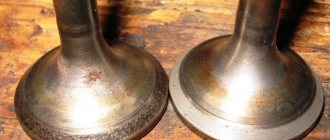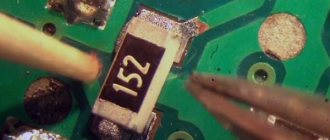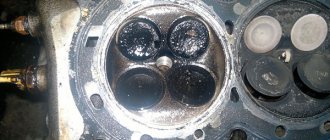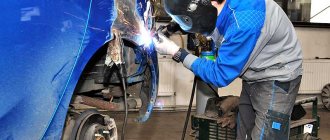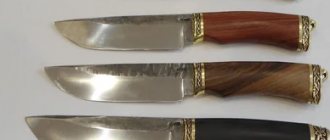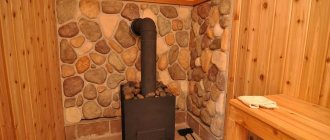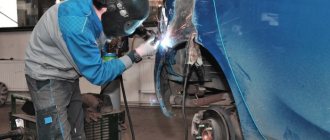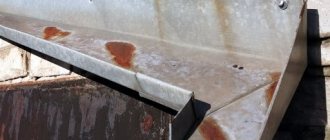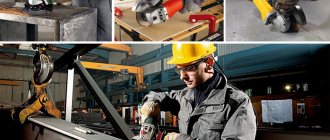Almost every owner of an old car, domestic or foreign, prefers to repair it on their own. Including rebuilding the engine. In this regard, quite often it is necessary to grind valves in home-garage conditions. And many people ask a logical question about why this procedure is required and how to properly grind the valves.
We also recommend reading the article on how to replace oil seals (valve seals) yourself. From this article you will learn about available methods for replacing valve seals, as well as how to change valve stem seals with your own hands.
DIY valve grinding paste
The required amount of lapping paste is applied to the valve and seat, and the valve is installed in its place in the cylinder head.
If a suction cup is used, it is installed on the valve plate.
The tool should operate at low speeds - preference should be given to a low-speed drill or screwdriver. Release the trigger of the drill when the valve comes into contact with the seat; the contact should be made when resetting. There is no need to apply any effort, this significantly increases the risk of improper grinding.
This is the easiest and most accessible way to grind a valve; it does not require any special skills. The device itself controls the angle and speed of rotation, which are optimal. The operating speed is even higher than that of a drill - just a few minutes are enough to grind one valve.
How much to rub?
How can you tell when the valve is ground in? There are several ways
- air check
- kerosene
- pencil
The vacuum tester performed best, which is not surprising, because the principle of operation of the vacuum tester is similar to the processes occurring in the engine. In the engine, gases break through the cracks, which we will check with this test.
The device is connected one by one to all openings on the intake and exhaust manifold sides and a vacuum is created. If the valves are poorly lapped, then there will be insufficient vacuum on the pressure gauge, as air breaks through the valves. This shouldn't happen.
Another test method, which is available in any garage, is the kerosene test. The valves are inserted into place, the head is placed with the combustion chamber facing up, and kerosene is poured on top. According to legend, if all the kerosene does not leak out overnight (or if it does not leak out at all? There are different opinions), then the valves are ground in correctly. But the inconsistency is that it makes no difference to the engine whether kerosene spills or not; air can either break through the connections or not, so this verification method can be neglected.
Another simple way is to check for uniform distribution of the marking substance. On the working edge of the valve seat, radial marks are drawn along the entire circumference. Then they insert the valve, press it and make rotational movements. Then they take out the valve and see what pattern has formed: if the marks have been erased and the entire surface of the seat is painted evenly, then it’s fine, it can work, if there are any irregularities, we continue grinding in.
Chevrolet car repair manuals and tips
Valve grinding is the most important stage of engine repair. In this article we will tell you what tools are needed and how to properly grind the valves with your own hands and check the quality. Tools for lapping valves Lapping paste for valves. The main thing you need to buy before starting the valve lapping process is lapping paste. During operation, it is applied to the edge of the valve and serves as fine sandpaper that rubs the valve into its seat.
There are many options for valve lapping paste. For example, such as in the picture in the form of valves. Valve lapping paste should be selected based on your finances and preferred manufacturer.
The lapping paste differs in the degree of processing: from coarse-grained (for initial processing) to fine-grained (for final processing). The latter is recommended by engine repair specialists, because... with it the process will go much faster. Everything depends not on the lapping paste itself, but on the condition of the valves and chamfers and the correctness of the process itself. For some, a regular tube of lapping paste for 100 rubles will do, but for others, give them only professional grade.
If you do it yourself, it’s better to start with regular lapping paste, not the most expensive one. If something goes wrong, then buy the one you need in the process.
“Sharoshka” for removing metal on the valve seat.
This tool is used to restore valve seats. The cutter is an attachment for the valve seat, made to fit the shape of the valve seat. It is usually fixed in a drill like a drill and is small in size.
Are grinders needed for grinding valves? We look at the saddles that are pressed into the head. If they are not damaged, then you can start lapping, but if the seats are damaged (burnout), then they need to be treated with special cutters. In general, the technology is as follows - first it is better to change the valve guides, then grinding in.
New valves are not always needed. If you find that the car’s valves are somewhat bent, then trying to straighten them will lead to nothing except wasted effort and time. A better idea would be to head to auto parts and purchase a new set of valves for the engine.
A little materiel
For those who are not in the know, it is worth explaining that the valves are located in the cylinder head. There are at least two valves for each cylinder (in most cars). One valve allows the fuel-air mixture to enter the cylinder (combustion chamber) from the intake manifold, and the other releases exhaust gases into the exhaust manifold.
Of course, the valves open one by one. The valves look like a nail. The head, which is also called a plate, is facing the inside of the cylinder. In the closed state, the valve head is in the seat and hermetically closes the combustion chamber, pressing the working chamfer against the seat.
We also recommend reading the article about the timing device. From this article you will learn about the purpose, operating principles and other features of the engine gas distribution mechanism.
Grinding in valves. How to do it right?
Valve grinding is a critical stage of engine repair. We'll tell you what tools are needed and how to properly grind the valves and check the quality. VALVE GRINDING TOOLS
Lapping paste for valves. lapping paste for engine valves. The main thing you need to buy is lapping paste. During operation, it is applied to the edge of the valve and serves as fine sandpaper that rubs the valve into its seat. There are many options for lapping paste. For example, such as in the picture in the form of valves. It should be chosen based on your finances and preferred manufacturer.
The lapping paste differs in the degree of processing: from coarse-grained (for initial processing) to fine-grained (for final processing). The latter is recommended by engine repair specialists, because... the process will go faster with it. Everything depends not on the paste itself, but on the condition of the valves and chamfers and the correctness of the process. For some, a regular tube of rubbing paste for 100 rubles will do, but for others, give them only professional grade.
Let's sum it up
So, as can be seen from all of the above, lapping is a responsible, labor-intensive procedure, but extremely necessary for good engine operation, not only after repair, but also after a mileage of over 60,000 kilometers. The only question that remains unclear is whether it is necessary to grind the valves on the new head.
Regarding this case, there are two options: if the head is completely new and was purchased fully equipped, then you don’t have to grind it in. In any case, experts say that this is not necessary. However, if the head was purchased separately from the valves, then grinding will be necessary. Again, in any case, before installing it, the tightness of the fit of the plates can always be checked in a well-known way, that is, by pouring gasoline or kerosene into the cylinder head or manifolds.
Source
Which lapping paste should I choose – GOI or VMP-Auto? + Video
1 The piston mechanism of a car engine - is it effective without lapping?
Home craftsmen use lapping paste to process car engine valves. The engine of any vehicle is a set of complex components and mechanisms. They will function correctly only in cases where all their elements interact harmoniously and clearly with each other. The problematic element of a car power unit is the valves. The compounds we are interested in are precisely used to improve the quality of their work. Lapping gives the following results:
- removing excess heat from valve plates;
- high level of tightness of the valve (connecting rod and piston) mechanism.
Valve lapping
We recommend that you read
After properly performed grinding, the gaps between the valves become minimal, which provides an important effect - increasing the overall level of compression of the mechanism. The motor begins to function without failure. The need for lapping most often occurs after an engine overhaul. And the procedure itself is performed using a lapping plate or cutters.
2 Types of lapping compounds - GOI and VMP-Auto
Mixtures used for processing parts in shipbuilding and mechanical engineering are made in the form of abrasive pastes (less commonly, powders). They can be coarse-, medium- and fine-grained. To work with engines, compounds with fine grains are usually used. But in some situations (old parts, large gaps between valves), coarse-grained pastes or powders are also used, intended for rough processing of surfaces made of aluminum alloys, copper, cast iron, and carbon steel.
Lapping paste
The most famous lapping paste among domestic motorists is GOI. It is produced in pieces of abrasive material or in cylindrical tubes 5 cm high, with a cross-section of 3.6 cm. GOI not only removes excess layers from metal surfaces and gives the latter minimal roughness, it also increases the wear resistance of the treated valves. Due to this, the parts last much longer.
GOI is a paste that belongs to the category of soft abrasives. It can be coarse, medium, fine. The first of these is characterized by a light green color. Coarse compounds are recommended for removing layers 20–40 microns thick. They are indispensable when it is necessary to remove traces of metal processing by grinding, scraping, and filing. Medium paste, which is dark in color, provides a cleaner surface. With its help, layers 8–20 microns thick are removed. And thin GOI is used for final grinding (up to 7 microns). It gives a mirror shine to the treated surfaces. The color of the thin paste is black with a slight greenish tint.
VMP-Auto lapping compounds are also widely used. This brand produces several types of pastes - professional, diamond, classic. They differ from each other in grain size. Professional VMP paste provides ground surfaces with a roughness of no more than 0.6, diamond – up to 0.5, classic – up to 0.7 microns.
The most popular diamond pastes with synthetic and natural diamond powder were developed by the domestic Institute of Superhard Alloys. Such compositions are usually divided into large, medium, small, and thin. Diamond paste is available in liquid, ointment-like and solid consistency. Motorists usually use liquid and paste-like formulations. They guarantee high precision and quality of valve machining.
It is advisable to use diamond pastes in conjunction with any cooling compound (light mineral oil, gasoline, kerosene). These fluids allow lapping to be performed faster and more efficiently, and also increase the accuracy of surface finishing.
3 We make the paste ourselves - if you don’t want to pay for a ready-made mixture
A simple and yet quite effective lapping compound is easy to make yourself. The pastes we are considering consist of powder, which is made from:
- Synthetic diamonds, boron carbide. Such pastes are used to remove excess layers from hard alloys.
- Silicon carbide. Compositions for processing brittle metals and cast iron.
- Electrocorundum (chromium, white or regular). This powder is most often included in pastes for lapping car engine elements.
Let's see how to make your own mixture for treating valves. You need to find some abrasive chips containing the already mentioned corundum or other powder. Such material is easy to obtain in any sanding device or machine. Just pick up some of the crumbs from the sandpaper stone.
If the machine has been used previously, the abrasive particles in it will be mixed with the metal. You should separate unnecessary impurities from the abrasive. This is done using an ordinary magnet. Spread the collected mixture on a flat surface. Bring a magnet to it and collect the abrasive, leaving unnecessary additives. After this, pour a little oil into the collected crumbs (you can use any) and thoroughly mix the composition until it becomes mushy. Homemade valve grinding is ready! Use it.
tutmet.ru
conclusions
As you can see, the lapping procedure is not only simple, there are also several methods to choose from, which makes the process even easier, especially if you do the work yourself and without special machines. In many ways, the quality of the work done depends on the correctly selected abrasive paste, so it is worth taking seriously the issue of preparing tools and consumables.
Every owner of a VAZ car, who prefers to repair his car himself, will sooner or later be faced with the need to grind in the valves of the gas distribution mechanism. The issue is pressing for many and requires careful study, after which it will be quite possible to cope with the task on your own, without resorting to the help of auto repairmen.
Nuances worth knowing about
To an experienced repairman, the tips below may seem unnecessary, but a novice repairman should definitely remember the following:
- It is better not to remove all rockers (cams on the valves) right away. It is necessary that each valve gets its own rocker back. While the engine is running, the camshaft cam and the corresponding rocker grind in and if they are “separated”, unpleasant clicks may appear when the valves operate, despite the fact that they have been properly adjusted before.
- And you also need to understand that each valve must return to its place. Changing them even after grinding in would not be the best idea.
- You can use various abrasive pastes in your work. You can start with the largest and end with the smallest. This will improve the results obtained.
- For a better fit, it is sometimes suggested to use machine oil at the finishing stage.
Valve grinding is carried out using various abrasive pastes
